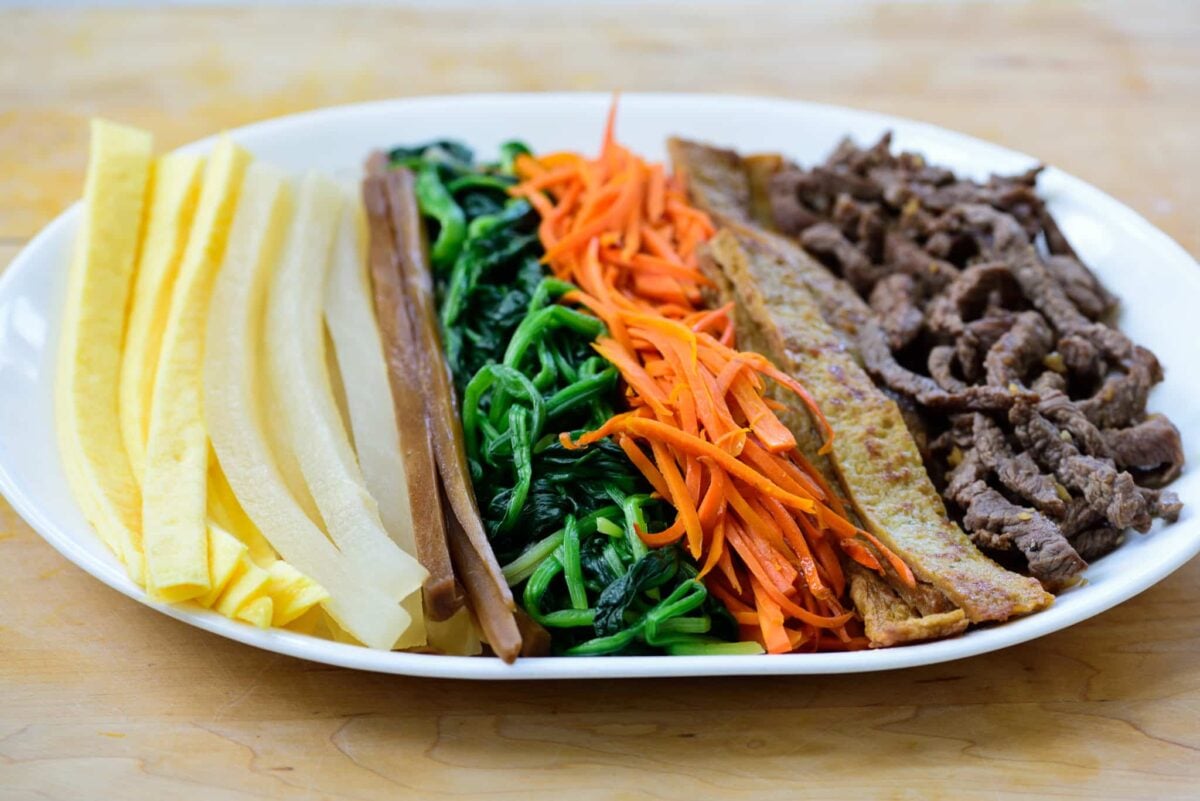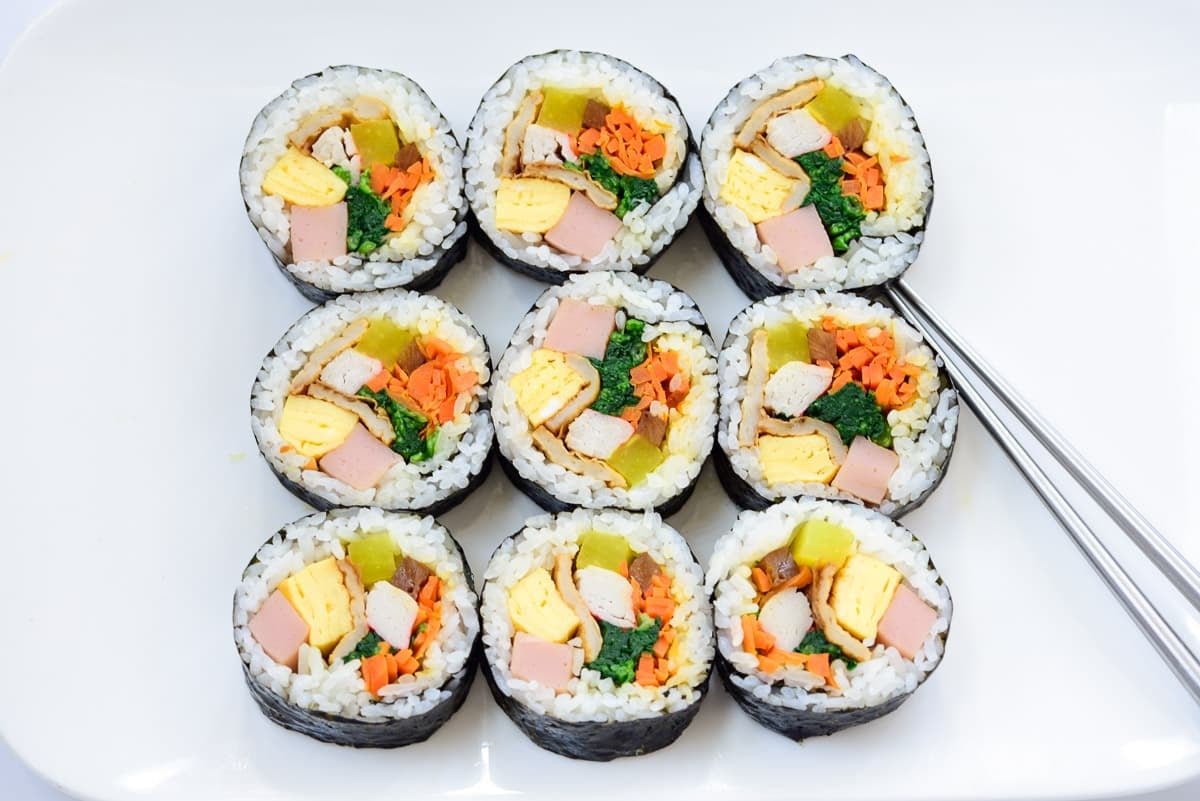Seaweed rice rolls, or kimbap
4 min read
Korea’s most popular meal-on-the-go is kimbap! Discover how to prepare a traditional version at home with this recipe that includes a detailed tutorial!
What is a kimbap?
A Korean seaweed rice roll called kimbap (also known as gimbap, 김밥) is stuffed with a variety of delectable ingredients. Rice is called bap, while seaweed is called kim (텀). These rice buns provide an intriguing blend of tastes and textures thanks to their varied fillings.
These rice buns were our childhood staple. Without them, our family road excursions, outdoor events, and school field trips would not have been the same! In Korea nowadays, kimbap is the most popular quick lunch. With so many variants, you can get it almost anywhere.
The traditional kimbap that my mother used to prepare for us on our field trips and picnic days is, in my opinion, the tastiest one. These homemade rice rolls are very delicious. While rolling takes some getting used to and preparing individual fillings takes some time, the procedure is simple and enjoyable.
Ingredients for a Kimbap
Seaweed rice rolls consist of three ingredients: rice, gum, and certain fillings. Although there are many possibilities for kimbap fillings, I’ve included the traditional components in this recipe:
- gim (nori, or dried seaweed)
- rice, either medium- or short-grain
- Danmuji, or pickled radish, is usually yellow, but if they’re available, I like white ones without food coloring.
- beef: ground beef, bulgogi meat, or any delicate cut of beef
- eomuk, fish cake, 어묵
- eggs
- carrots
- Cucumber or spinach work well as alternatives. For cucumber preparation directions, see my vegan kimbap.
- Burdock root (械旉): Packages of burdock root that have already been prepared for kimbap are often seen next to pickled radishes (danmuji). Or you may use my recipe to create your own.

The quantity and number of filling components may be changed to suit your preferences. Add whatever items you prefer, or exclude those you don’t want to have or desire.
Gim, or dried seaweed
Seaweed sheets for sushi, or kimbap, may be purchased online or at Korean or Asian stores. They are gently toasted and just thick enough to support all the ingredients, plus the rice.

Kimbap rice
You must use rice with short grains. I sometimes add some multigrain or brown rice for healthier alternatives. Use a bit less water while cooking the rice to make it a little drier than usual. Then, for the nutty and savory flavor that Korean kimbap is renowned for, gently season it with salt and sesame oil.
About 3/4 to 1 cup of cooked rice is needed for each roll. I used 1.5 cups of uncooked rice for 4 rolls in this recipe. Five or six rolls may be made from two cups of cooked rice.
Getting the filling ingredients ready
The filling is easy to make, but preparing the components takes some time. Since every ingredient—including the rice—will be seasoned, season each one lightly. Burdock roots and pickled radish are very salty.
Replace the fish cake, eggs, and beef with extra veggies, tofu, etc. to make a vegan kimbap. See my vegan kimbap as well.

Adaptation: Kimbap Woo, Young Woo
The Korean drama Extraordinary Attorney Woo on Netflix helped to popularize Woo Young Woo kimbap on social media (summer 2022). Woo is an intelligent lawyer who suffers from autism spectrum disorder. She loves kimbap and consumes it for every meal. Kimbup, in her opinion, is reliable. She can quickly see all of the components, so there are no surprises when it comes to texture or flavor.
What exactly is in the Woo Young Woo kimbap, then? Egg, spinach, carrot, braised burdock root (ueong jorim), fish cake (eomuk), crab sticks, and ham. Not a fight! These are all very typical components of kimbaps. You can easily make this at home by replacing the beef in the recipe with pan-fried Korean ham and imitation crabmeat, such as crab sticks.

kimbap rolling
To what extent is rolling difficult? Although it requires some skill, the second roll is much simpler. Roll it firmly by using your hands to create consistent, firm pressure throughout the roll. If you are new to this, start with a little bit of each filling.

Advice on preparing a kimbap
- For kimbap, freshly cooked rice works best. Until it’s time to utilize it, keep it warm.
- When all the components for the filling are prepared, season the rice. While the rice is still hot or warm, mix it with salt and sesame oil.
- Eliminate any extra water to keep the filling components as dry as possible.
- Season all of the filling ingredients lightly. Burdock roots and pickled radish have a salty taste.
- To stop the rice from sticking to your hands as you put it across the seaweed, moisten your fingertips with water or sesame oil. Having a small dish of water or sesame oil next to your rolling station is helpful.
- Cut your rolls with a sharp knife. Slice with precision, completing the whole slice at once. If needed, wipe the knife with a moist kitchen towel in between slices.
- The sliced gimbap should be kept in an airtight container. Although gobo is best consumed the day it is prepared, it may be refrigerated and reheated in a skillet or microwave. We sometimes pan-fry chilled gimbap after dipping it in egg batter. A mouthwatering take on the gimbap!







